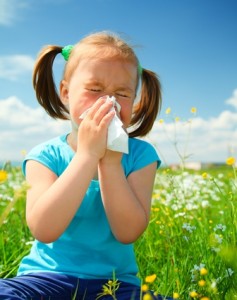
Cold vs. allergy symptoms in kids: What’s the difference?

When allergy season kicks into high gear, kids may have a multitude of cold-like symptoms. Both seasonal allergies and a cold can cause a runny nose and sneezing. So how can you tell what’s causing your child’s symptoms?
“A cold and a reaction to seasonal allergies can sometimes look similar,” said Jaya Wadhawan, MD, a pediatrician for OSF HealthCare. “But there are some symptoms that can make it easier to spot the difference, if you know what you’re looking for.”
Cold symptoms
Common colds are caused by a virus and typically last 5-7 days.
Fever
If you’re wondering, “can allergies cause a fever,” the answer is no. A fever with a cold, however, can be very common.
Sore throat
A cold with a sore throat is more common than a sore throat caused by allergies.
Body aches
Viral colds can typically have you feeling achy and fatigued, which can be treated with plenty of rest, hydration and pain relievers.
Allergy symptoms
Seasonal allergies are immune system responses to allergens, such as seasonal tree or grass pollens.
- If your child has itching of the eyes, nose or skin, it’s most likely allergies. A cold does not cause itching.
- Allergies usually cause symptoms that last longer than two weeks.
- Allergy symptoms come in a predictable pattern. For example, if symptoms show up every spring or every summer, this typically indicates your child has allergies.
If you suspect your child has allergies, knowing what some of the common allergens are can help you identify what might be causing your child’s symptoms.
Is it a cold or allergies?
Indoor allergens include:
- Foods
- Dust and mold
- Animals, such as cats, dogs, rabbits, birds, gerbils, guinea pigs and others
- Clothing and toys, particularly ones made or trimmed with animal hair
- Latex or bacterial enzymes in items such as rubber gloves and balloons, elastics in clothes and cleaning products
Outdoor allergens include:
- Pollen, particularly from March until mid-June, when pollen counts are high
- Grass, which causes summer allergies from June until about August 15
- Ragweed in the fall, which usually extends from mid-August until the first frost
The best ways to relieve your child’s allergy symptoms are to control your child’s exposure to allergens and to use over-the-counter medications per your doctor’s instructions.
Tips for allergy relief
Controlling exposure to allergens
- Dust mites: Use pillow and mattress covers, stay away from down blankets or feather pillows, do not allow stuffed animals in the bed with your child and wash stuffed animals and linens regularly.
- Outdoor allergens: Use air conditioning as much as possible, bathe and change your children’s clothes after they play outside and keep windows closed at night.
- Mold: Avoid playing near moist piles of leaves and have moisture-rich areas of your home checked regularly for mold.
Medications
- Oral medications: Many long-acting, non-drowsy medications that are available are safe for children ages 2 and older. Talk to your child’s doctor to see which one is right for your child.
- Nasal spray: Nasal saline spray is simply water with salt, which is a natural way to help loosen mucus and congestion from the nose. It also aids in helping kids blow their noses. Children can use it as many times a day as needed and then practice blowing their noses.
If you’re not sure if your child’s symptoms are caused by a cold or by allergies, it’s best to speak to your doctor. There are different forms of allergy tests available, such as a blood test or skin-prick test. An allergist can provide more detailed information on what kinds of options are available.